Have you ever wondered how many potatoes can grow from just one potato? If so, you’re not alone. Potatoes are globally cherished and versatile vegetables, arousing curiosity about their cultivation and yield potential.
In this article, we will explore the intriguing realm of potato cultivation and introduce ten high-yielding potato varieties capable of producing an abundance of spuds from a single-seed potato. Join us as we uncover the impressive yields these varieties can offer!
Contents
How Many Potatoes Grow from One Potato Plant?
The number of potatoes that can grow from a single plant varies due to factors such as:
- Potato variety,
- Growing conditions,
- Cultivation practices.
Now, How many potatoes grow from one seed potato?
In potato cultivation, one seed potato has the potential to yield several tubers. A healthy potato plant generally produces 6 to 12 tubers, though this count can occasionally surpass the average range.
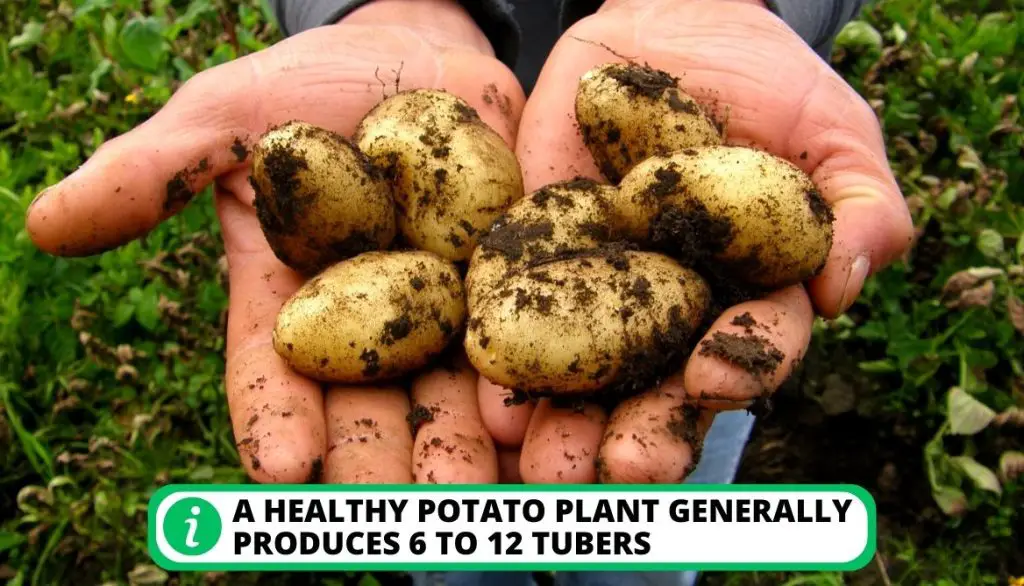
Selecting an Ideal Location for Potato Farming
Potatoes grow generally in cooler temperatures and well-drained soil. The optimal temperature range for potato growth lies between 60°F (15°C) and 70°F (20°C). When choosing the best location for planting potatoes, consider the following key factors:
- Climate: Regions with mild summers and cool nights provide favorable conditions for potato cultivation. They require a frost-free growing season lasting approximately 70 to 120 days.
- Sunlight: Potatoes grow in full sun exposure. Potato plants indoors need a minimum of six hours of direct sunlight daily.
- Soil: Potatoes grow in loose, well-drained soil with good fertility. Ideal soil types include sandy loam or loamy soil. Avoid heavy clay soils that retain excessive moisture, as it can lead to rotting.
- pH Level: The soil pH should be slightly acidic to neutral, ideally ranging between 5.8 and 6.5.
- Water Drainage: Proper drainage is essential for potatoes, as waterlogged conditions can cause rot. Ensure adequate drainage to avoid such issues.
- Growing Season: Plan your planting time based on the length of your growing season. Potatoes can be planted in early spring when the soil is workable or in late summer for a fall harvest.
- Disease Resistance: Consider selecting organic potatoes that are resistant to common diseases prevalent in your region. This can enhance the chances of a successful crop.
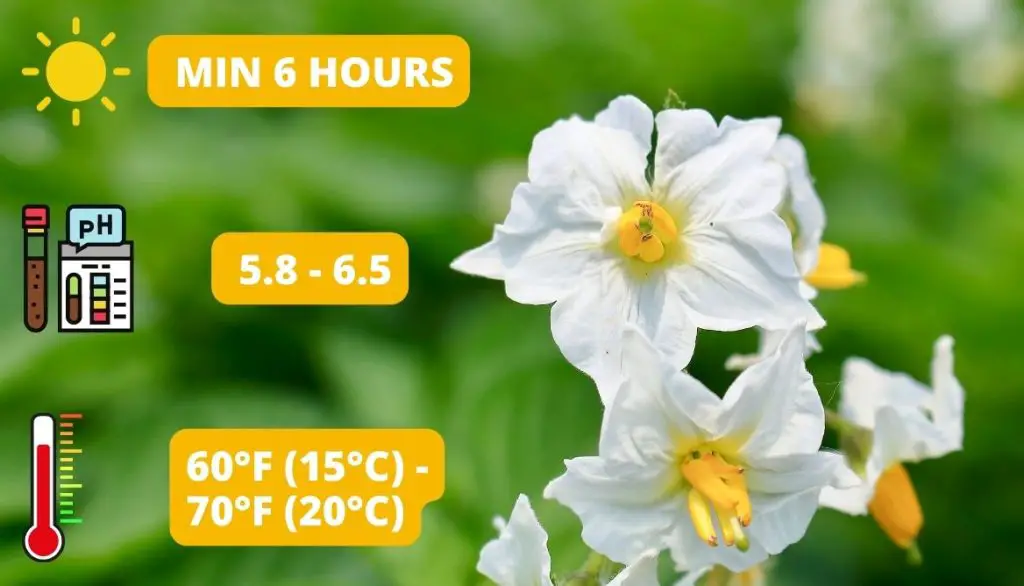
1. Growing Potatoes In Bags And Buckets
Cropping potatoes in bags or buckets is a popular method for small-scale gardening since potatoes grow underground. It allows you to cultivate enough potatoes without requiring a large garden or bed plot.
Here’s a step-by-step guide on how to grow potatoes using this method:
- Select a deep container with drainage holes.
- Fill the container with a well-draining potting mix. You can also create a mixture of compost, soil, and sand for optimal growing conditions.
- Prepare the seed potatoes by cutting larger ones into pieces with an “eye” and allowing them to dry. This helps develop a callus, promoting better sprouting.
- Place a layer of soil in the container and plant the seeds, ensuring the eye side is facing up. Cover the potatoes with soil, leaving enough room for growth.
- Maintain even moisture in the soil, making sure not to overwater. Potatoes require consistent moisture without excessive saturation.
- Choose a location that receives at least six hours of direct sunlight daily. This will support the growth and development of the plants.
- As the potatoes grow from one seed, cover the stem with soil to encourage more yield and prevent greening.
- Apply a balanced fertilizer or compost tea every 2-3 weeks to provide essential nutrients for healthy growth.
- Regularly monitor for pests and diseases and take appropriate measures to protect your potato plants.
- Harvest the potatoes when the plants die back or the foliage turns yellow. This indicates that the tubers are mature and ready for harvesting.
- Store the harvested potatoes in a cool, dark, and dry place to prolong their shelf life.
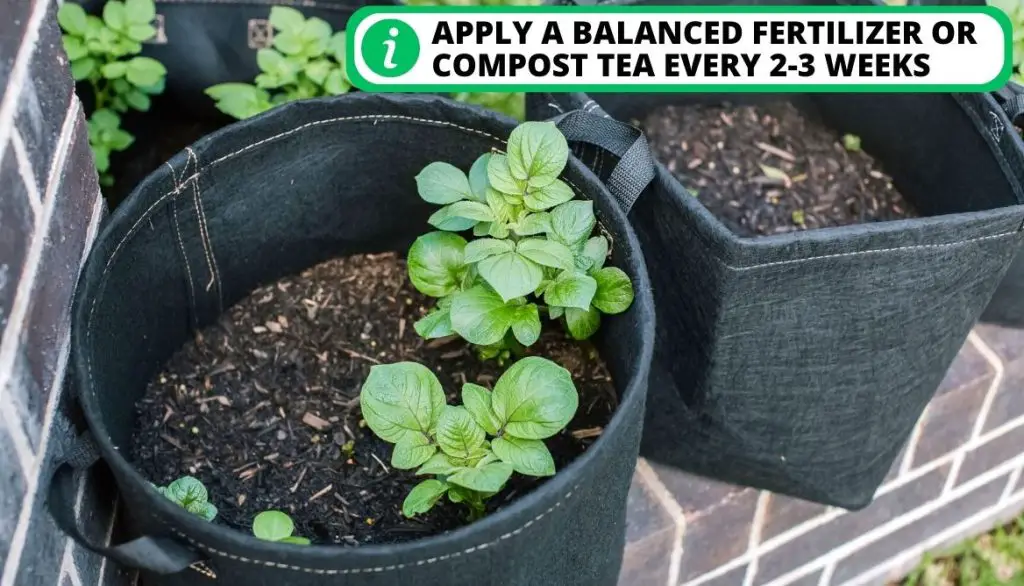
2. Growing Potatoes In Cardboard Boxes
Sowing organic potatoes in cardboard boxes is another alternative and it is a similar concept to sowing root crops like potatoes in bags or buckets but you use cardboard boxes as the container.
Here are the steps to follow:
- Choose sturdy cardboard boxes at least 12-18 inches deep with drainage holes.
- Line the box with old newspaper, and ensure drainage holes are present.
- Cut larger potatoes into seeds with an eye, and let them dry to develop a callus.
- Fill boxes with well-draining potting mix/compost, soil, and sand.
- Place soil in the boxes, plant potatoes (eye-side up), and cover them with soil.
- Keep the soil damp but not waterlogged.
- Position boxes in a location with at least six hours of direct sunlight.
- Cover stems with soil as potatoes grow from one seed.
- Use balanced fertilizer/compost tea every 2-3 weeks.
- Pest and disease monitoring: Watch for pests/diseases, and take appropriate measures.
- Harvest potatoes when plants die back or turn yellow.
- Store harvested potatoes in a cool, dark, and dry place.
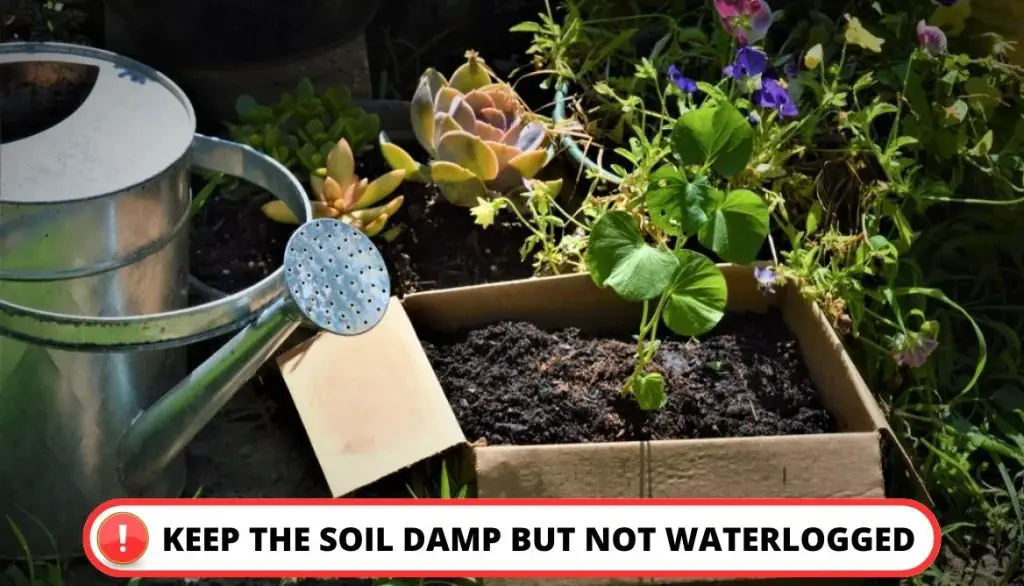
How Does Planting Depth Affect the Number of Potatoes from One Seed Potato?
Planting depth can have an impact on the number of potatoes produced from a single-seed potato. The depth at which you plant the seed potato can influence the growth and development of the potato plant, which in turn affects the yield.
- Proper planting depth allows the seed potato to develop strong roots and access sufficient nutrients and moisture from the soil.
- You are advised to plant potatoes 4 to 6 inches (10 to 15 centimeters) deep when planting them.
- This depth of planting gives the potato tubers enough soil coverage to shield them from sunlight, which could trigger greening and render them unusable.
- If you plant potatoes too shallow, they may be more prone to damage from environmental factors like temperature fluctuations, pests, or disease.
- On the other hand, if you plant them too deep, it can hinder the sprouting process and slow down the growth of the plant.
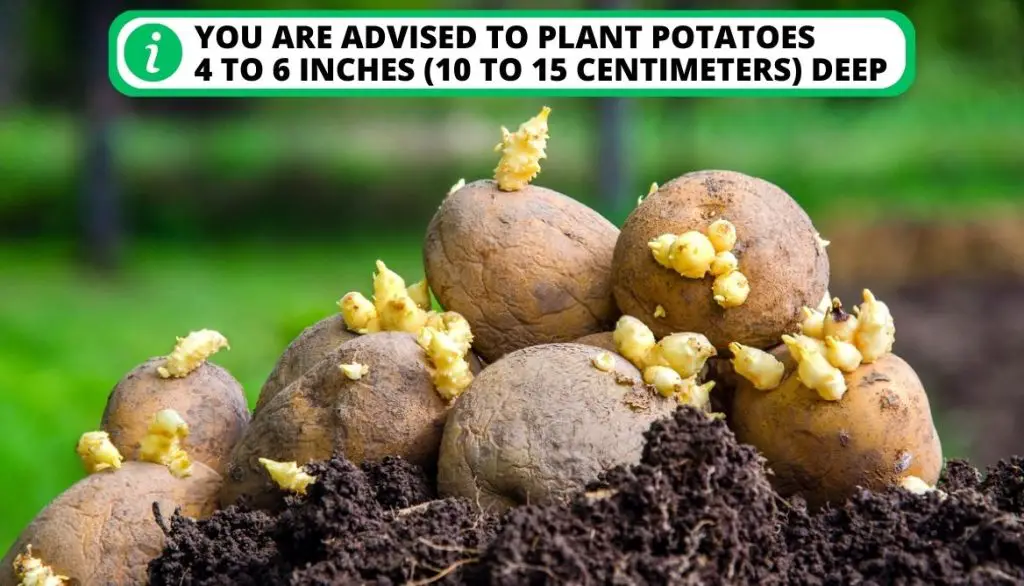
The Role of Soil Moisture or Fertility in the Development of the Number of Potatoes from One Seed Potato
Soil fertility and moisture can affect how many potatoes are produced from one seed potato. Here’s how:
Soil Fertility
Potatoes especially sweet potatoes are heavy feeders and require nutrient-rich soil to produce a good yield. Adequate levels of nutrients like nitrogen, phosphorus, and potassium are particularly important for potato growth.
If the soil is deficient in these nutrients, it can result in poor tuber development and reduced yield. Therefore, ensuring that the soil is fertile and well-balanced in terms of nutrients is crucial for maximizing potato yield.
Soil Moisture
Adequate moisture is also important throughout the potato’s growth cycle, particularly during tuber formation. Insufficient moisture can hinder tuber development, while excessive moisture can lead to issues like rotting and disease.
However, it’s important to consider other factors such as temperature, sunlight, disease management, and planting practices, as they all contribute to the overall health and yield of potato plants.
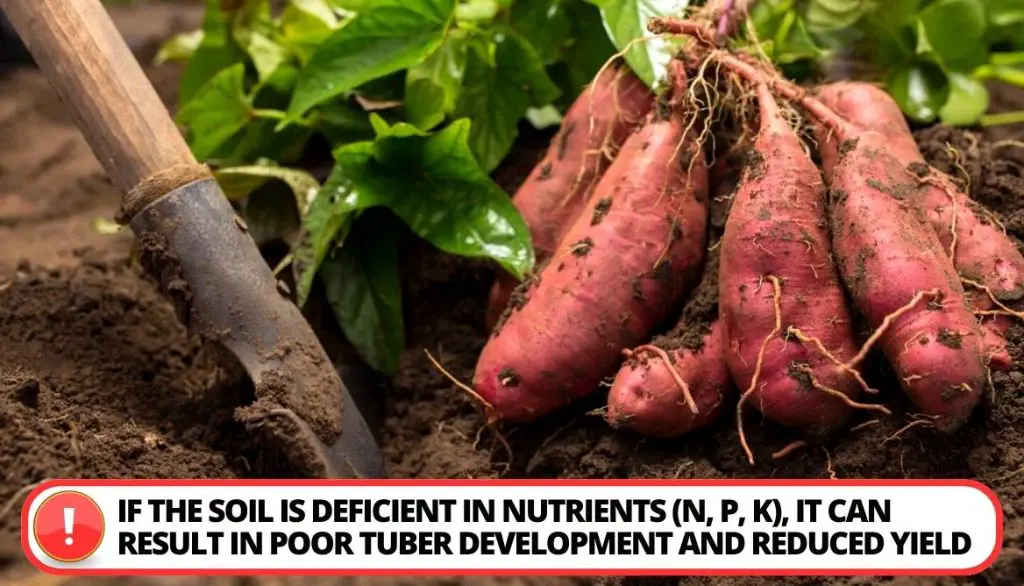
How Far Apart To Plant Potatoes?
When planting potatoes mostly sweet potatoes, it’s important to space them correctly for healthy growth and maximum yield.
However, How many potatoes should be grown in a row? See the following recommendations:
- Traditional Row Planting: Space seeds 12-15 inches (30-38 cm) apart within rows, with 2-3 feet (60-90 cm) between rows.
- Raised Beds or Containers: Space potatoes 8-12 inches (20-30 cm) apart in all directions, considering the looser soil and better drainage.
- Intensive Planting: For maximum space utilization, plant potatoes 6 inches (15 cm) apart within rows, with 12 inches (30 cm) between rows.
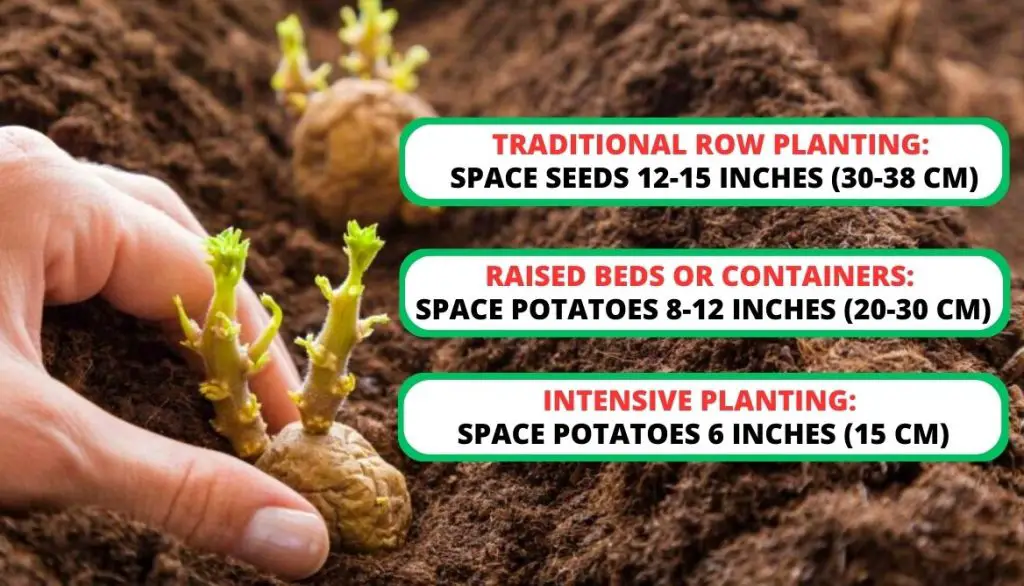
Remember to consider the potato variety, available space, and your preferences when adjusting the spacing.
Varieties of Potatoes Seeds And Plant Spacing
There are many different potato types, each with special qualities and adaptability for various growing environments. It’s crucial to take into account aspects like cooking properties, disease resistance, and yield potential while choosing a potato variety.
Additionally, the spacing between potato plants is crucial for optimal growth and productivity. Here’s the table for the popular potato kinds and their recommended spacing:
Potato Variety | Spacing between Plants |
Russet Burbank | 12 to 15 inches (30-38 cm) |
Yukon Gold | 9 to 12 inches (23-30 cm) |
Red Pontiac | 9 to 12 inches (23-30 cm) |
Kennebec | 9 to 12 inches (23-30 cm) |
Fingerling | 6 to 9 inches (15-23 cm) |
Spacing Large Potato Varieties
When growing large potato varieties, it’s important to provide adequate spacing to ensure the plants have enough room to grow and develop tubers. Here’s a table of general guidelines for spacing large potato varieties:
Potato Variety | Spacing between Plants |
Idaho Russet | 15 to 18 inches (38-46 cm) |
Atlantic | 15 to 18 inches (38-46 cm) |
Shepody | 15 to 18 inches (38-46 cm) |
King Edward | 15 to 18 inches (38-46 cm) |
Maris Piper | 15 to 18 inches (38-46 cm) |
Spacing Smaller Potato Varieties
To guarantee healthy growth and ideal yields, sufficient spacing is still crucial when it comes to smaller potato cultivars. The following common recommendations are for spacing smaller potato varieties:
Potato Variety | Spacing between Plants |
New Potatoes | 6 to 9 inches (15-23 cm) |
Salad Potatoes | 6 to 9 inches (15-23 cm) |
Please note that these spacing recommendations are general guidelines, and specific varieties may have slightly different requirements.
Techniques For Growing Potato Plants
There are several gardening techniques you can use for growing potato plants, depending on your available space, climate, and personal preferences. Here are some popular gardening methods:
- Conventional In-Ground Method: Plant seed potatoes into the ground, keeping the appropriate distances between them in mind. Around the developing stems, gradually add more soil or mulch as they grow.
- Elevated Bed Technique: Construct raised beds using soil that has been properly enriched. Place potato seed within the beds and incrementally add soil or mulch as the plants develop.
- Container Gardening: Grow potatoes in containers with a well-draining potting mix. Ensure proper spacing and add soil or mulch as the plants grow.
- Vertical Gardening: Using towers or bags to grow potatoes vertically. Place potato seeds in layers with soil or straw, and add more layers as the plants grow to allow their expansion.
- Hydroponics/Aquaponics: Grow potatoes using soil-less systems with nutrient-rich water or fish waste circulating around the roots.
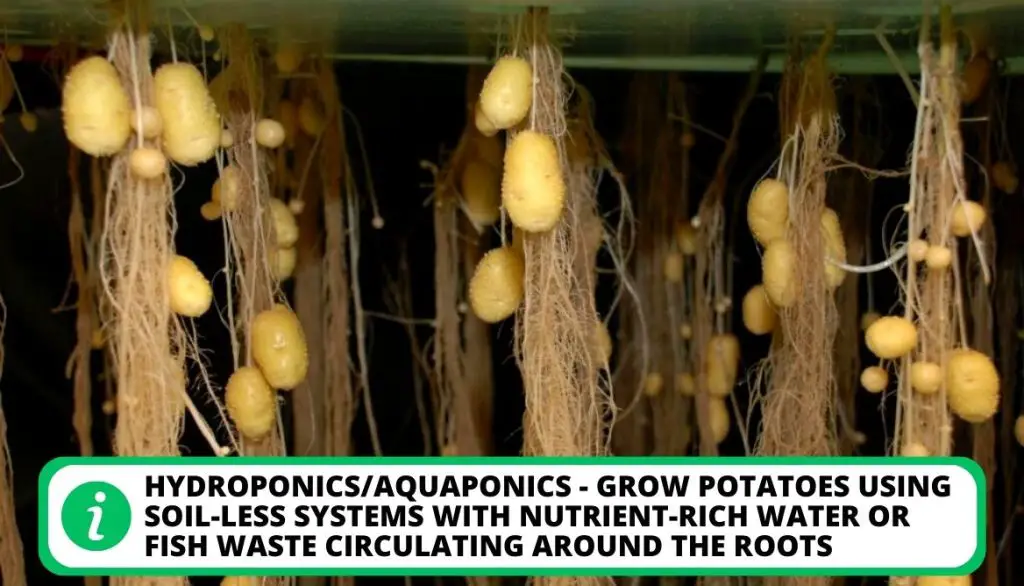
Square Foot Gardens for Potato Plants
Square-foot gardening is a popular method that maximizes space efficiency by dividing the garden into square-foot sections. Here’s a suggested approach for square-foot gardening with potatoes:
- Prepare the square-foot garden by constructing elevated beds or using containers.
- Allocate 1 square foot per potato sprouts within the garden.
- Use a well-draining soil mix enriched with compost and organic matter.
- Plant a single seed potato in each square, ensuring proper depth.
- Provide regular watering, monitor for pests and diseases, and use mulch to retain moisture and suppress weeds.
- Harvest potatoes when mature, being careful not to damage other plants.
While square-foot gardening may not yield as many potatoes as traditional methods, it can still be a rewarding way to grow your own potatoes in smaller spaces.
Farm-Style Spacing
Farm-style spacing refers to the traditional spacing used to make potato plants grow on a large scale and facilitates farming operations. Here are the key points to remember;
- Row Spacing: Rows of potato plants are typically spaced 30 to 36 inches (76 to 91 cm) apart to allow for machinery access and airflow.
- Intra-row Spacing: Within each row, each potato plant is spaced 10 to 12 inches (25 to 30 cm) apart to ensure adequate sunlight, nutrients, and water for healthy growth and bigger potato tuber development.
- Hill Spacing: In some cases, potatoes are planted in mounds or hills, with hills spaced 30 to 36 inches (76 to 91 cm) apart, and seed potatoes within each hill are spaced 10 to 12 inches (25 to 30 cm) apart.
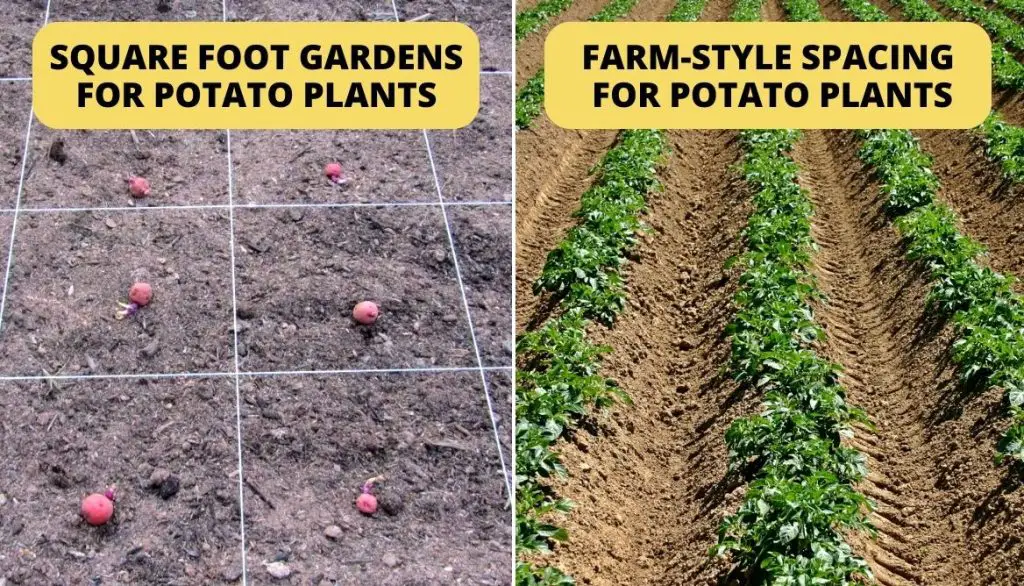
High-Yielding Potato Variants
Selecting high-yielding potato breeds is crucial for maximizing your potato harvest. You also need to consider culinary preferences when choosing the right high-yielding potato variety. List of High-Yielding Potato kinds:
- Yukon Gold: Known for its smooth, golden-fleshed tubers and is mostly used in potato salads.
- Russet Burbank: Widely grown with high starch content and excellent baking qualities.
- Kennebec: Renowned for high yields, disease resistance, and suitability for various cooking methods.
- Maris Piper: Popular in the UK, valued for high yields, excellent french fries, and roasting qualities.
- Desiree: Red-skinned variety with high yields, ideal for boiling, mashed potatoes, and baking.
- King Edward: Classic variety with high yields, attractive red skin, and versatile culinary uses.
Guidelines To Boost Your Potato Yield
By implementing these recommendations, you can enhance growing conditions, promote healthy plant growth, and raise your potato output.
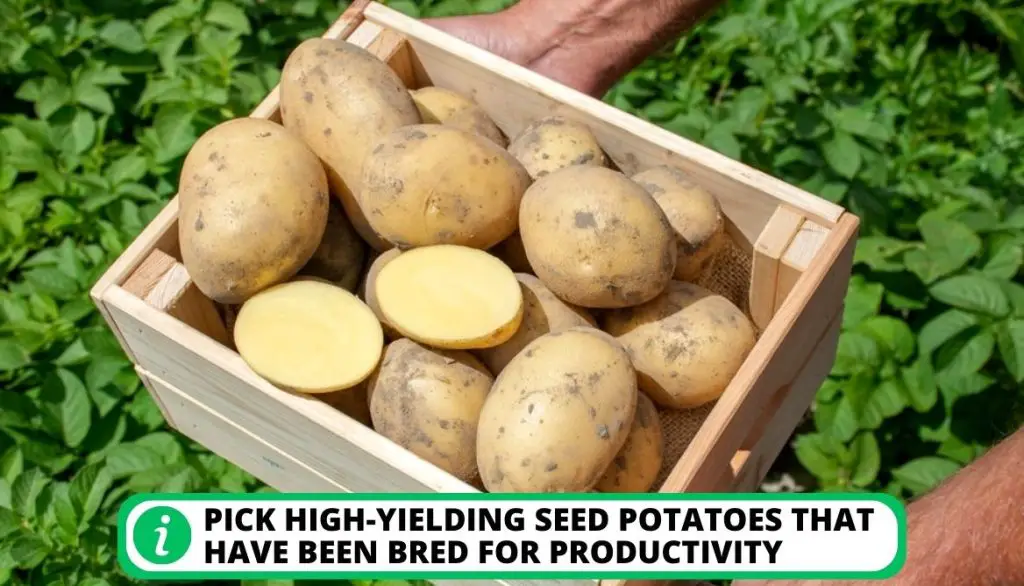
- Pick high-yielding seed potatoes that have been bred for productivity.
- Start with healthy, disease-free seed potatoes.
- Make sure the soil is well-prepared by adding organic matter, such as compost.
- Provide adequate spacing between potato plants for better growth.
- Fertilize appropriately, paying attention to potassium levels.
- Avoid overwatering and maintain regular, appropriate irrigation.
- To keep weeds out and moisture in, mulch the area around the plants.
- Create a mound of mulch or soil around the stems to promote tuber growth.
- Control illnesses and pests by regularly observing them and taking appropriate action.
- You should harvest plant produce at the right time, ensuring careful handling and proper storage.
FAQ
How many potatoes grow from one seed?
A potato usually produces 5 to 10 potatoes, however, this number might vary.
How many seed potatoes are in 1kg?
1 kg contains approximately 10 to 15 seed potatoes per kilogram. The number of seeds in 1kg can vary depending on the size of the seed potato.
How many potatoes are in a 2kg bag?
The number of potatoes in a 2kg bag will depend on the size of the potatoes. You can expect to find approximately 10 to 20 potatoes in a 2kg bag.
Do potatoes multiply when planted?
Yes, one potato plant can grow many potato tubers, but potatoes do not multiply in the sense of forming seeds or generating progeny.
How do you get potato seeds in 7 days?
As for getting potato seeds in 7 days, it is not possible to obtain traditional seeds from potatoes in such a short time frame.
Conclusion
The number of potatoes produced from a single potato can fluctuate, with an average yield typically ranging from 5 to 10 potatoes per seed potato. This outcome is contingent upon various factors, including size, variety, and the prevailing growing conditions.
To maximize your potato harvest, it is crucial to choose high-yielding breeds and ensure optimal growing conditions are met.
When growing potatoes in your garden, which variety will you choose? Leave your preference in the comment section. Thanks for Reading.
- How to Get Potatoes to Sprout Eyes: Detailed Growing Guide with 3 Options - July 31, 2023
- Weight of a Medium Potato: Revealed in Detailed Guide - July 29, 2023
- Maris Piper Potatoes: 9 Substitutes You Should Know About - July 27, 2023
Hello! I’m Jessica Zander, a garden coach and consultant based in the Boston area (zone 6b), offering virtual consultations across the country and Canada.
I’ve been passionate about gardening since the early 1990s, and in 2022, I launched You Can Do It Gardening to empower individuals to feel more confident in their gardening endeavors.
Following a 30-year career in nonprofit finance and operations, I transitioned out of that field in mid-June of 2023 due to the growing demand for coaching services. Interestingly, my years of presenting financial statements to boards and finance committees proved to be valuable experience for teaching people about gardening! I enjoy sharing skills, providing guidance and suggestions, and collaborating efficiently with clients to make significant improvements to their outdoor spaces, both small and large. I also regularly teach at the Arlington Continuing Education and Cambridge Adult Education.
My approach is direct and practical, akin to Mary Poppins, but tailored to your garden. Clients find satisfaction in saving money and taking pride in their own gardening achievements.

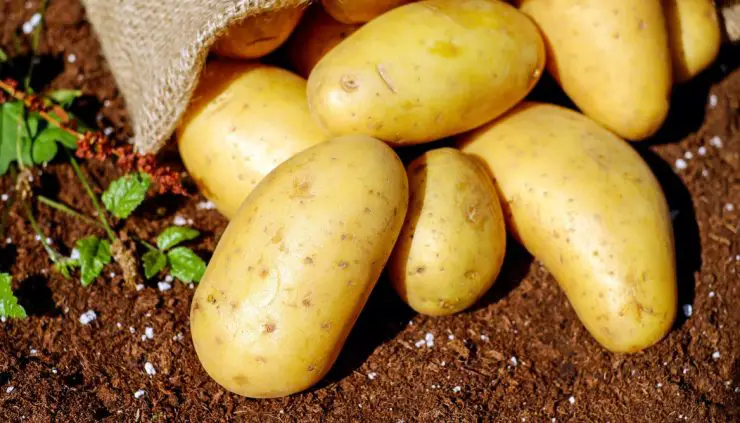
Add comment